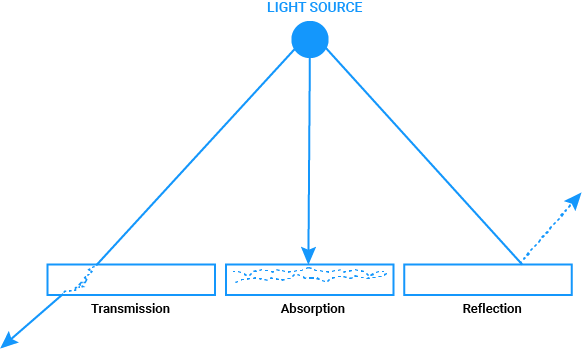Infinite Diversity of Materials
The world we inhabit is made of so many different things, both natural and human-created, along with light from our sun, fire, or artificial light. The number of particulates in the atmosphere (and type) and, of course, weather, all affect how we perceive what it is that we see in our environment. When we record these images onto our digital devices or photographic film, through glass lens elements, we are affecting the final outcome of what we can see even more.
OctaneRender®, as a spectral rendering, unbiased path tracer, is most concerned with light, or the absence of light, and how light interacts within the environment defined in a scene. Materials are how we tell OctaneRender how we want objects to appear when rendered. In fact, creating materials amounts to a good portion of the typical Octane experience.
The rendering process effectively documents the path of a light ray from the camera as it traverses throughout the scene until the ray concludes at the origin of the light source that cast it (reverse from real life, which goes the other way around). Rendering, by the simplest definition, mimics how light photons hit the surface of an object and react according to the properties of that surface. The appearance that we perceive of a surface is actually determined by the structural (chemical/organic/metallic) and optical texture (smooth/rough) of the surface itself, as well as anything that may be riding above the surface (liquid/dirt particles/coating). These factors determine how a given light ray will interact with a surface. When a light ray hits a surface, three types of interaction occur:
1- Can be Absorbed by the surface.
2- Can be Transmitted to the other side of the surface.
3- Can be Reflected from the surface.

Some materials absorb certain wavelengths of light and may also reflect some wavelengths and even emit light when absorbing radiation (an effect known as fluorescence, viewable under ultraviolet radiation). As always, the interaction of radiant energy (electromagnetic radiation, AKA light) to the surface follows the Law of Energy Conservation: the sum of the energies absorbed, transmitted and reflected by a surface equals the sum of the energies coming to the surface. This rule applies separately for each wavelength of light throughout the spectrum whose quantities are determined in ratio to the incoming energy (i.e., relative). These ratios are different for each material and surface geometry and seem to be more related to matter structure. Accordingly, for a material surface, these ratios are called transmittance, absorbance, and reflectance, respectively.

